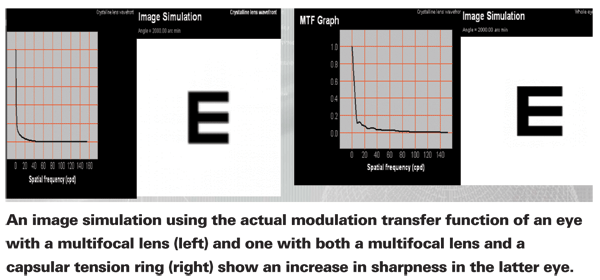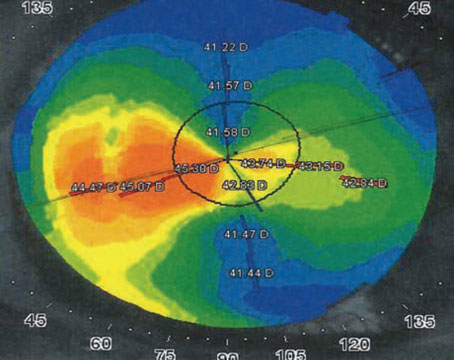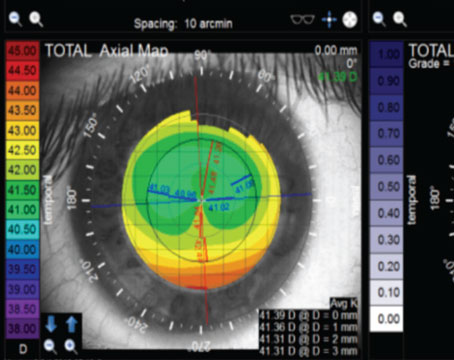Sometimes you can achieve better results using two devices in combination than you could with either one used by itself. I discovered this in my work with multifocal/diffractive presbyopic lenses. When I became somewhat dissatisfied with the occasional misplacement of the multifocal intraocular lenses in some patients, I was sure something better could be done to guarantee stability in the eye. To that end, I combined the implantation of the multifocal lens with a capsular tension ring, and was pleasantly surprised with my results. Here's my procedure and its current outcomes.

My Goals
For me, the ideal multifocal IOL would have one dominant point of focus, preferably for distance vision. I'd also prefer it to be aspheric, in order to reduce spherical aberration; toric; non-pupil dependent and have a healthy near add of greater than 3.5 D to give adequate vision at about 40 cm working distance. It should also have good optical performance, of course, both at the optical research bench and in actual use. Naturally, we want all of our lenses to be stable in the capsular bag and have a low rate of posterior capsule opacification. The stability issue can become crucial, as I've found tilt and decentration to be major causes of photic complaints and starburst phenomena. Also, any posterior capsule opacification can cause light scatter that significantly decreases the visual performance of a multifocal IOL.
Following my studies on lens position inside the eye using a multifocal IOL, I noticed some decentration and tilt that was limiting the results. Some of the patients had small problems at the location of the lens loops that, when injected, resulted in lens tilt and important subjective complaints of visual phenomena. To remedy this, I started implanting a capsular tension ring along with the IOL, and initiated a study to determine the results of this technique.

Testing a New Method
In an effort to decrease this lens tilt, and also the associated visual complaints, I performed a study of 78 eyes. Forty-six eyes would receive just a diffractive multifocal IOL, the AcriTec AcriLISA (Carl Zeiss Meditec), while the other 32 would receive an AcriLISA as well as the AcriTec AcriRing CTR. Since optical quality in vivo can be challenging to measure, I used the VOL-CT v. 7.11 software from Sarver and Assoc. (
During the procedure, I implant the AcriRing CTR just before the IOL injection. I inject the lens through a 1.7-mm incision, using the corneal-wound assistance technique, which is a technique that uses the corneal wound as an extension of the injector, allowing the surgeon to use a smaller incision than he would be able to use otherwise.
It turns out that the group with the tension ring combined with the lens experienced a statistically significant reduction in intraocular aberrations. (See Figure 1) The outcome measures broke down as follows:
• total aberrations for the tension-ring group were 1.04 ±0.52 µm vs. 1.45 ±0.73 for the lens only group (p=0.008);
• lower-order aberrations in the tension-ring group were 0.95 ±0.55 µm compared to 1.36 ±0.73 µm for the lens group (p=0.009);
• spherical aberration was 0.21 ±0.07 µm for the tension-ring group vs. 0.25 ±0.1 µm for the lens only patients (p=0.04);
• coma-like aberrations in the tension-ring group were 0.29 ±0.13 µm compared to 0.36 ±0.21 µm for the patients who received just lenses (p=0.09);
• the tension-ring group exhibited statistically significantly lower values of intraocular astigmatism compared to the lens only patients, 0.46 ±0.21 vs. 0.7 ±0.75 (p=0.05);
• the average root mean square effect of lens tilt was 1.09 ±0.56 µm vs. 1.3 ±0.68 for the lens only group, which wasn't statistically significant (p=0.17).

Ultimately, the CTR group had better lens centration with significantly improved positioning and stability in the capsular bag than the patients who only received a diffractive lens.
Currently, guaranteeing bag stability is an issue with modern IOL technologies in which sophisticated optics such as diffractive technology are being used, and in which lens position is going to negatively affect visual results. Because of this, I'm now using a capsular tension ring for every multifocal or diffractive lens I implant. I stop short of using them with accommodative lenses, since they follow a different optical strategy and need to be tested separately. But, who knows? Combining an accommodative lens with a CTR may also yield a visual system that's more than just the sum of its parts.
Dr. Alió is professor and chairman of ophthalmology at







